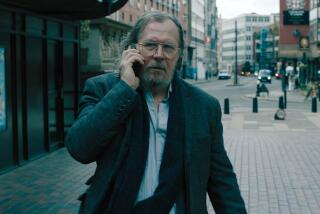Review: Why George Clooney’s ‘Catch-22’ for Hulu may make you yell at the screen
Adaptation is interpretation, and interpretation by definition generates disagreement; no matter how well-supported the reasoning, I may never understand just why it is you chose to portray Oliver Twist as an 80-year-old woman or have Hamlet deliver his speeches backwards.
Nespresso spokesperson George Clooney, properly back on the small screen after a couple of decades, and his producing partner Grant Heslov, have turned Joseph Heller’s 1961 satirical World War II novel “Catch-22” into a six-part miniseries, debuting Friday on Hulu. Produced and partially directed by Clooney and Heslov along with Ellen Kuras, and written by Luke Davies (“Lion”) and David Michôd (the Australian film “Animal Kingdom”), it departs substantially from its print original.
Sometimes, this is for the practical reasons that any translation of a sprawling, densely populated book demands. But it also differs in spirit: If a friendlier, more dramatically and morally conventional “Catch-22,” with a more relatable central character — the bombardier Yossarian (a solid Christopher Abbott), who only wants to get out alive, in the face of the Germans shooting at him from below and the superior officers oppressing him from above — is what you desire, this is it. Such a thing is, admittedly, not on my wish list, nor does this adaptation convince me it should have been.
Granted, “Catch-22” is as difficult to put onscreen, in its way, as James Joyce’s “Ulysses,” since so much depends on language, and the illogical logical tricks you can play with it. (“He did not hate his mother and father, even though they had both been very good to him” is a typical Heller twist of thought.) There is a character in the book named Major — — de Coverley who in the TV adaption (where he’s played by Hugh Laurie) loses his redacted first names. A plane that “disappears into a cloud,” permanently, in the book, is just another casualty here.
ALSO: Why Joseph Heller’s ‘Catch-22’ is a relevant antiwar satire in the age of Trump »
Mike Nichols, with Alan Arkin as his Yossarian, took a starry, big-screen crack at it in 1970 — less than a decade after the novel’s publication, and at a time when its themes jibed with the Vietnam anti-war movement — and was not successful, though his film does a better job than the present series at catching the book’s tonal shifts, from absurdist comedy to bleak poetry. There was also an unsold 1973 TV pilot, currently available online, featuring Richard Dreyfuss, clearly made under the influence of “MASH,” which, of course, had been made under the influence of “Catch-22.”
Here, Davies and Michôd have taken the novel’s curlicue structure, which jumps around in time on the hinge of a stray thought, and straightened it out into a conventional chronology. This is sensible enough, though viewers have proved pretty adept at dealing with the flashbacks and flash forwards, not to say parallel realities and multi-level dream states, which more than a few modern television series employ.
The idea seems to have been to render a fairly realistic, even sentimental version of the book’s narrative highlights, with occasional brief forays into its Marx Brothers absurdities. There are some admirable things in the series, some of which reflect the source material, and some of which work on their own terms, but generally speaking, the better you know the book, the more likely you are to yell at the screen, in the later episodes especially. Where it strikes off on its own, whether in dialogue or wholly new scenes, it tends to get obvious and flat.
The book spends a lot of time in its people’s heads — all but a few of its chapters are named for a character — but, apart from Yossarian, the series hangs around on the outside; most characters are barely developed. As a result, the fear and striving that characterize the show’s superior officers — Clooney’s parade-obsessed Lt. Scheisskopf (the name is a rude word in German) and Kyle Chandler’s Col. Cathcart, who keeps raising his squadron’s required number of missions — are only fitfully glimpsed. But each actor is at his best in scenes where his character is in the presence of someone who scares them. Their spittle-flecked ranting is less persuasive.
ALSO: ‘The Big Bang Theory’ is ending, but we shouldn’t let multi-cam sitcoms die. Here’s why »
For a contemporary reader, the novel’s great obstacle is its treatment of women, who exist mainly as sex objects, whether they’re nurses, WACs or prostitutes. That’s not to say all are devoid of dimension or agency — indeed, they can make the men look like dopes — but some of what the book treats lightly would be rightly recognized as sexual assault today. Still, apart from Tessa Ferrer’s Nurse Duckett, who becomes a bemused foil to the sometimes goldbricking Yossarian, the solution here, such as it is, has been not to round out Heller’s models but just to push the female characters into the background, or eliminate them altogether. (This also has the perhaps intended effect of making the male characters come off better.) The woman known in the book only as “Nately’s whore” gets a name here, and a certain tangential respectability — Nately (Austin Stowell) has practical plans to settle down with her — but she is also essentially an extra.
The flight scenes are convincingly executed, with fleets of bombers navigating oceans of flak, and the dark drama of the pivotal scene focused on the wounded flyer Snowden (Harrison Osterfield) is well-handled. But the series is at its best when it most directly conveys the novel’s lunacy, the “Who’s on First?” bureaucratic reasoning that finds full flower in Catch-22 itself, a rule for all seasons — and a term that people who have never read the book use regularly — whose most famous expression is that any flier who is crazy can be grounded, but only if he asks to be; yet asking only proves his sanity, and so he must continue to fly.
Similarly, there is Maj. Major Major Major (Lewis Pullman), who will never see anyone when he’s in his office, though visitors can go right in when he’s out. Above all, there are the scenes involving Milo Minderbinder (an excellent Daniel David Stewart), the war-profiteering mess officer, whose exploits are so fantastic that there is no way to reduce them to ordinary drama; the miniseries does well by him.
Inevitably, much is left out. Sadly, some of that saved screen time is given over to problematic elaborations and inventions. These include a trip with Milo to Oran, which puts Yossarian and his tentmate Orr (Graham Patrick Martin) into tuxedos, in which the former is called upon to impersonate an industrialist; an idyll in an Italian country town, in which a wounded, recovering Yossarian, dressed in farmer’s clothes, flirts with a farmer’s daughter; a scene in which Clooney’s Scheisskopf examines Yossarian’s testicles in order to assess his claims of injury; and an ending markedly different from Heller’s, which you will just have to see when, and if, you get there.
----
‘Catch-22’
Where: Hulu
When: Begins streaming Friday
Rated: TV-MA
Follow Robert Lloyd on Twitter @LATimesTVLloyd
More to Read
The complete guide to home viewing
Get Screen Gab for everything about the TV shows and streaming movies everyone’s talking about.
You may occasionally receive promotional content from the Los Angeles Times.







